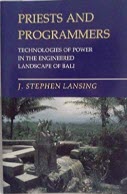Priests and Programmers: Technologies of Power in the Engineered Landscape of Bali
- Title
- Priests and Programmers: Technologies of Power in the Engineered Landscape of Bali
- Original language
- Author(s)
- Illustrator(s)
- Publisher
- Princeton University Press
- ISBN
- —
- Publication date
- June 21, 1991
- Subjects
- subak
- Find Book
- Related Env. Initiatives
- Related Places
- Related Biographies
- Related Children's Books
- Related Holidays
- Related Folktales
- Related Comics
- Related Lontar
- Linked words
Description(s)
For the Balinese, the whole of nature is a perpetual resource: through centuries of carefully directed labor by generations of farmers, the engineered landscape of the island's rice terraces has taken shape. According to Stephen Lansing, the need for effective cooperation in water management links thousands of farmers together in hierarchies of productive relationships that span entire watersheds. With unusual clarity and style, Lansing describes the network of water temples that once managed the flow of irrigation water in the name of the Goddess of the Crater Lake. Based on a system of power relations so subtle as to be completely overlooked by colonial administrators, the practical role of the temples was unnoticed until the advent of the "Green Revolution" of the 1970s. Lansing shows how the water temples then lost control of cropping patterns, a series of ecological crises developed, and the bureaucratic model of irrigation control was shown to be hopelessly over-simplified. Today the ancient system of water temples is threatened by development plans that assume agriculture to be a purely technical phenomenon. Using the techniques of ecological simulation modeling as well as cultural and historical analysis, Lansing argues that the material and the symbolic form a single complex--a historically evolving system of productive relationships that is the true unit of analysis. The symbolic system of temple rituals is not merely a reflection of utilitarian constraints but also a basic ingredient in the organization of production.







Enable comment auto-refresher